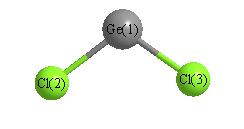Vibrational Frequencies calculated at AM1
| Mode Number |
Symmetry |
Frequency
(cm-1) |
Scaled Frequency
(cm-1) |
IR Intensities
(km mol-1) |
Raman Act
(Å4/u) |
Dep P |
Dep U |
|---|
| 1 |
A1 |
434 |
413 |
20.08 |
10.38 |
0.07 |
0.12 |
| 2 |
A1 |
145 |
139 |
14.30 |
6.57 |
0.65 |
0.79 |
| 3 |
B2 |
444 |
424 |
38.37 |
9.73 |
0.75 |
0.86 |
Unscaled Zero Point Vibrational Energy (zpe) 511.6 cm
-1
Scaled (by 0.9535) Zero Point Vibrational Energy (zpe) 487.8 cm
-1
See section
III.C.1 List or set vibrational scaling factors
to change the scale factors used here.
See section
III.C.2
Calculate a vibrational scaling factor for a given set of molecules
to determine the least squares best scaling factor.
